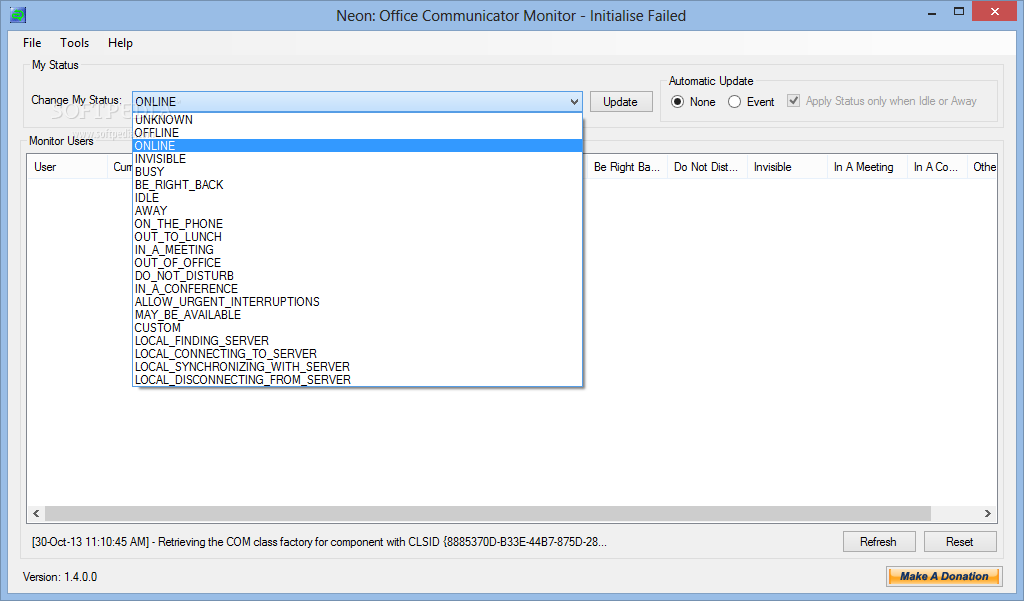Microsoft Communicator For Mac
Joining Microsoft Messenger is a new business counterpart in Office 2011 for Mac, Microsoft Communicator. Both products offer similar features and interfaces, but each is designed for a different market:
Microsoft Messenger: Uses your Windows Live ID (such as your Hotmail e-mail address) to communicate with contacts using public servers. Requires a Windows Live account to sign in.
Microsoft Communicator: Designed to use fully updated Microsoft Exchange Server 2007 or later to communicate within a closed business environment. The corporate contact list has been moved from Messenger to Communicator. Communicator supports Microsoft Exchange Global Address List (GAL).
Microsoft still plans to maintain Messenger for Mac as a free download, but the team is unlikely to support non-productivity-centric features, like games or winks, according to the post.
Both Messenger and Communicator offer a variety of ways to communicate, collaborate, and share work. Logging in to either product involves a simple username and password sign-on.
Managing contacts in Microsoft Messenger and Communicator
The Contact List displays when you open Messenger or Communicator. Starting at the top, you have access to a lot of tools:
Add: Displays the Add a Contact dialog.
Send: Click the Send button and then choose a contact from the pop-up menu to open a text instant message conversation window.
Call: This feature requires speakers and microphones on both ends of the call. Communicator supports PC to phone dialing.
Video: This feature requires video camera, speaker, and microphones on both ends of the call.
Send File: Click and then choose a contact from the pop-up menu. You see a file Open sheet, which you can use to choose a file or photo to send to the selected contact.
Page: Click and then choose a contact from the pop-up menu. If you haven’t set up your mobile message preferences, the Preferences dialog opens. Normally, Page displays the Page message input window. Type a text message to be sent to your contact’s cellphone or mobile device.
Mail: Opens your Web browser to view your mail account. Displays how many unread messages you have in your inbox.

Indicating Presence in Messenger and Communicator
The Presence Indicator is a new feature of Office 2011. It has these buttons across the bottom:
Send Mail: Opens a new browser window to a new, blank, pre-addressed e-mail message window.
Send Instant Message: Opens a conversation window and requests the contact to engage in a text chat session.
Voice Call: Sends a request to establish a voice call. This feature requires speakers and microphones on both ends of the call. Communicator supports PC to Phone dialing.
Video Call: Sends a request to establish a video call. This feature requires video camera, speaker, and microphones on both ends of the call.
Schedule Meeting: Opens a new Meeting dialog in Outlook.
Open Outlook Contact: Opens the Contact in Outlook.
Tmg client for mac. Forefront TMG Client sends user information transparently with each request, enabling you to create a firewall policy on the Forefront TMG 2010 computer with rules that use the authentication credentials presented by the client. Forefront TMG 2010 allows you to configure automatic discovery for Forefront TMG Client computers, using: Active Directory, WPAD entry in DNS, or DHCP to obtain correct Web proxy settings for clients, depending on their location. Install it on the Mac side. When TMG generates a Word document, you can click on it in the PC environment, and the computer will rummage around until it finds MacWord, and open it even from the Windows side. OR you can drag the Word file over to the Mac desktop and open it directly in MacWord there. (Word is SLOW).
Add to Contact List: Adds this person to your Messenger or Communicator Contacts List.
Phone Number: In Communicator, click to initiate a telephone call.
Instant messaging with Office 2011
When you choose to send an instant message, the Message Conversation dialog opens. The dialog lets you chat using text. You can also use the following features in the Message Conversation dialog:
Save: Saves the dialog of your chat. Messenger only.
History: Displays the Conversation History window. Messenger only.
Open Drawer: Opens the side drawer and displays Contact pictures.
Presence Indicator: Click to display the contact’s Presence Indicator.
Close Drawer: Closes the side drawer.
Input area: Type your message or drag a file into this section.
Font: Click to change characteristics of the font you send.
Reviewing conversation history in Messenger and Communicator
When you click the History button or press Command-O in Messenger, the Conversation History dialog appears. You get the following options:
Save as Web Page: Saves the selected conversation in HTML that can be opened in a Web browser.
Print: Prints the conversation.
Delete: Deletes selected conversation.
Search: Find conversations using keyboards.
Show/Hide toolbar: Click this little button when your toolbar disappears and you want it back.
